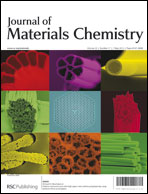Transfection of luciferase DNA into various cells by cationic cyclodextrin polyrotaxanes derived from ionene-11†
Abstract
Cationic polyrotaxanes for gene delivery have been generated by threading amine-functional cyclodextrins (CDs) onto polyionene cores. These polymers were used to condense nucleic acids into polyelectrolyte complexes of <200 nm radius. Gel retardation and dye exclusion assays demonstrated tighter binding of CD-threaded polyrotaxanes compared to their non-threaded ionene counterparts. Atomic force microscopy showed the presence of well-condensed polyrotaxane–DNA complexes at nitrogen : phophorus (N : P) ratios >1 : 1 and complexes with partly uncondensed DNA at lower N : P ratios. Transfection assays using a luciferase reporter gene in three representative cell lines indicated that a hexamino-CD-based polyrotaxane was an effective nucleic acid delivery agent, inducing comparable and even superior transgene expression levels as poly(ethyleneimine) (PEI). Furthermore, the polyrotaxanes were better tolerated by all three cell lines than PEI as reported by the MTT metabolic activity assay. These data indicate that polyrotaxanes of this type are promising gene delivery agents both in vitro and in vivo.


 Please wait while we load your content...
Please wait while we load your content...